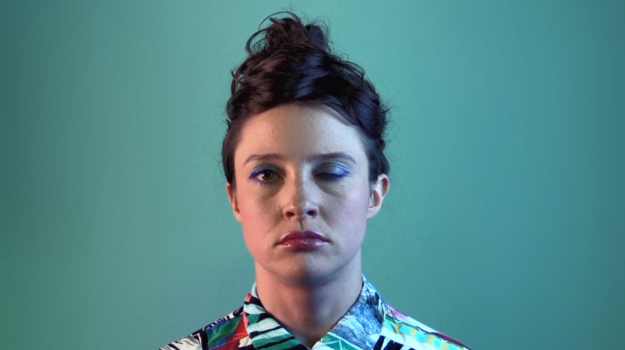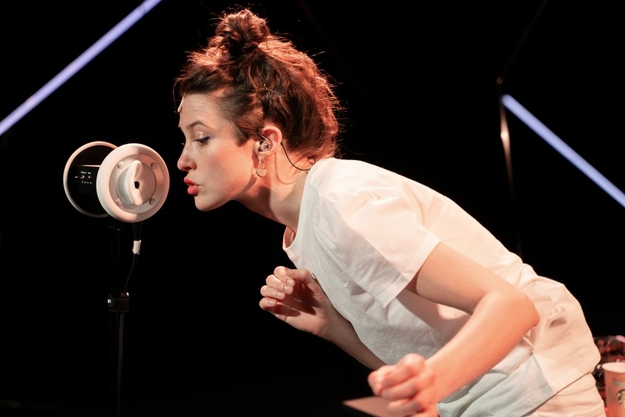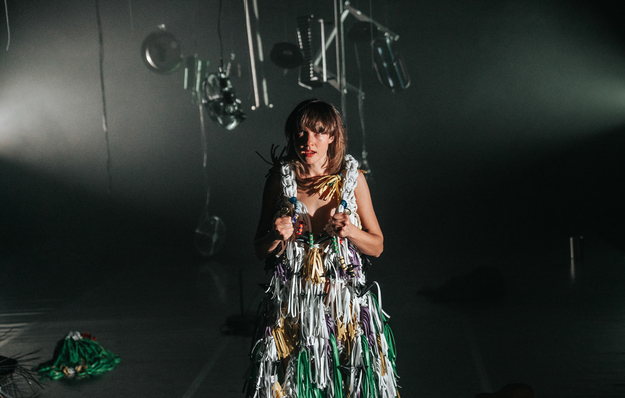Q: Can you introduce a bit about yourself as an artist?
A: My background is in composition. I moved to the Netherlands because I was doing my masters at the Hague Conservatoire. While I was there, I also combined composition with choreography to create dance performances, which became my entrance into performance. Currently, I combine composing for musicians, classical ensembles and performing my own music with experimental pop-rock. In my own performance work, I've created three solo productions that bridge between music and theatre. Generally I work within these diverse approaches.
Q: What's the inspiration behind your focus on psychology and disability?
A: These pieces always come from my personal experience or perspective. A lot of works are autobiographical, or it’s analyzing a certain emotion that is then being broadened to look at society and other people's experiences. I think I’ve always been emotional myself. My mother’s a visual artist, and she told me to channel my emotions through my work when I started to compose around sixteen.
Around the age of 26, I went to quite intensive therapy and it helped me view my emotions from a distance. This was an opening for me to make things more relatable to the audience, creating work that is more communicative. That's also been a massive step in my everyday life. My brother has learning difficulties and autism, and is unable to really articulate what he's feeling and going through. It's not that I know what autism is like, but as a sister, I understand the complexity of it and the level of sensitivity that he experiences.
That really inspires me within my work, particularly when it comes to sensuality, feelings, certain textures, or hearing certain sounds in my work. My brother would get so fascinated by a certain feeling of material or listening to some sounds, and by picturing him, I bring myself back down to verify the making of my performance work.
Q: Thank you for sharing this with us. What was your experience creating your performance of “Your Feeling” in collaboration with Julian Hetzel, which later became part of the spoken word concert “I Don’t Want to Be An Individual All on My Own”?
A: I was inspired by the subject of empathy, trying to understand what empathy is and this concept of feeling another person's feelings. Are they actually my feelings that I’m projecting onto them? How distant or connected are we? How much are we actually just interpreting for ourselves? Empathy is important, but there are a lot of questions around this emotion.
This was also at the time when COVID started, so all of a sudden, we were all in isolation. There was something interesting about making a music video and working with this screen in between myself and the viewer. How expressive can I possibly be? How does that come across to the audience? If I really push out my emotions, do I actually push people away or bring people closer?
In terms of research, I'm not sure, but I noticed that when people watch it, sometimes they also do the expressions and try for themselves, even without knowing it. It’s interesting to think of empathy with synchronicity, when it comes to mirroring other people's emotions.
Still image from the video "Your Feeling" by Genevieve Murphy and Julian Hetzel -

Q: Do you feel closer to this other person and these feelings when you're practicing these facial movements?
A: It definitely helped me understand the emotional journey in that video, to feel what I'm going through. The music and the lyrics are about feeling another person's feelings and saying that they're yours and not mine, yet trying to understand how to access a person. I believe there is an empathetic feeling in the way I made the music. Performance-wise, I did feel emotionally in touch with the subject. Though these faces are also like a party trick and this was fun! It definitely affected how I travelled through the song, and I think Hetzel and I made it fit perfectly together with the subject.
Q: Your works often explore the intersection of sound, text, physical performance, and imagery. How do you integrate these elements to convey your artistic message?
A: Yeah, I always think about the subject first, and then what the piece needs depending on the context. Is it going to be a concert or theatre piece? There are also practical questions in regard to the audience. How are they seated? What's the setup? What's the energy that I need to give?
For example, “I Don’t Want to Be An Individual All on My Own” is about empathy. Since we couldn’t be very close to each other at the time, I decided to create a feeling of physical closeness by whispering into their ear through headphones. I use a binaural microphone as a way to find intimacy. It’s in the middle of the stage but also in the audience's ears - as though each audience member is sitting in the middle of the stage. In this theatre setup, I create an immersive experience for each person, so they feel a bit like they have a solo show while sitting in amongst one another.
Genevieve performing 'I Don't Want To Be An Individual All On My Own' - Photo by Bas de Brouwer . 
When I was looking into the subject of empathy, I realised that authors who write novels are the most effective when it comes to working with this emotion. Just by following text on paper you escape into a world where you completely empathise with the characters; and create your own image of them. Depending on the level of detail, authors bring their own emotions into their project and transmit what this person looks like, what they act, how they’re feeling, etc.
So I wanted to make it a storytelling piece and to stimulate images through sound. Those sounds don’t relate to actual visuals, but for example, I use something similar to a reel-to-reel cassette tape, rustle that into the microphone and talk about being in the bushes. Then immediately, the sound triggers the audience to be inside the bushes. It’s demonstrating how sound can trigger imagery but also become a set design. With certain elements you evoke the audience’s imagination and help them create that world. And then the song "Your Feeling" comes in. I perform it live. That's the moment when I kick somebody in the shin. I'm very young–eight years old in this piece. I don't understand this person, I kick him and this is the first moment where I recognise that oopsie, I've really hurt this person. It's my first memory of experiencing empathy and feeling like, oh, maybe I shouldn't have done that. I witnessed his expressions and how he reacts. It's such a vivid memory - it stays with me, a significant moment where I made contact without realising what it would do and then learning very quickly about the effect.
Q: I watched that part of your performance. There is a strange guest during the child’s birthday party so the protagonist feels scared but curious at the same time.
A: Exactly. What I understood is that if you're afraid of something you block empathy. For example, I’m afraid of spiders - I don’t understand them and I therefore need them to go away. In order to overcome that fear and develop empathy, you need to become curious. I tried to share my curiosity towards aspects in the story that made me feel uncomfortable. The more you study something or someone and view their behaviours the more you learn about them, find commonalities between them and you and can empathise.
Q: You mention the theme of discomfort in your work. How was your experience of navigating through the discomfort when you were studying in the conservatory, if there was any?
A: I arrived at The Hague knowing what I wanted to do, which was to make a dance piece, but I was completely out of my depth in choreography. My teacher, Martijn Padding, advised me to make sure it's not “shit”. I understood I had to learn about the language of dance, took dance classes, and researched extensively over two years. The conservatoire was a safe place to feel uncomfortable, experiment, and learn. It allowed me to try and take steps without knowing if they'd work. I developed a system that allowed me to still be a composer who is now working with bodies, which helped me feel more at ease. It's important for artists to keep evolving and trying new things, even if it means stepping into unknown territory and sometimes failing. These experiences help you learn and push your creative boundaries.
Q: And how would you say those experiences have informed your work along the way?
A: Navigating discomfort has been crucial. When I received a subsidy from FPK (Fonds PodiumKunsten), it was a significant boost for my performance and production work. I had to learn new formulas and ways to be more performative, which was very different from traditional composition. Now, I'm going back to music, but still in a performative context, exploring how to let the music drive the narrative.
Q: You mentioned that fear plays an important role in your creative process. For artists or art students who identify themselves as neurodivergent or whoever finds themselves different and have doubts about themselves, maybe you could share something about reflecting on those discomforts in art?
A: If you don’t know what you've made is good or not, that's often a sign you're on the right track.